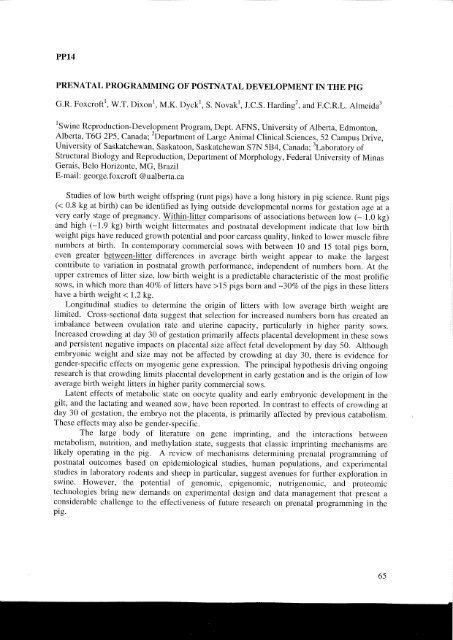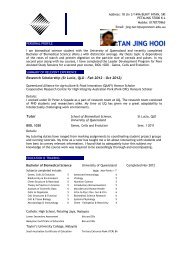Untitled - Pork CRC
Untitled - Pork CRC
Untitled - Pork CRC
You also want an ePaper? Increase the reach of your titles
YUMPU automatically turns print PDFs into web optimized ePapers that Google loves.
PP1.4<br />
PRENATAL PROGRAMMING OF POSTNATAL DEVELOPMENT IN THE PIG<br />
G.R. Foxcroftl, w.T. Dixonr, M.K. Dyckl, s. Novakr, J.c.s. Harding2, and F.c.R.L. Almeida3<br />
tSwine Reproduction-Devel-opment Program, Dept. AFNS, University of Alberta, Edmonton,<br />
Alberta, T6G 2P5, Canada; 2Department of Largé Animal Clinical Sciences, 52 Campus Drive,<br />
University of Saskatchewan, Saskatoon, Saskatchewan S7N 584, Canada; 3laboratory of<br />
Structural Biology and Reproduction, Department of Morphology, Federal University of Minas<br />
Gerais, Belo Horizonte, MG, Brazll<br />
E-mail: george.foxcroft @ualberta.ca<br />
Studies of low birth weight offspring (runt pigs) have a long history in pig science. Runt pigs<br />
(< 0'8 kg at birth) can be identified as lying outside developmental norms for gestation age at a<br />
very early stage of pregnancy. Within-litter comparisons of associations between low (- 1.0 kg)<br />
and high (-1.9 kg) birth weight littermates and postnatal development indicate that low birth<br />
weight pigs have reduced growth potential and poor carcass quality, linked to lower muscle fibre<br />
numbers at birth. In contemporary commercial sows with between 10 and 15 total pigs born,<br />
even greater between-litter differences in average birth weight appear to make the largest<br />
contribute to variation in postnatal growth performance, independent of numbers born. At the<br />
upper extremes of litter size, low birth weight is a predictable characteristic of the most prolific<br />
sows, in which more than 40Vo of litters have > 15 pigs born and 4AVo of the pigs in these litters<br />
have a birth weight < 1.2 kg.<br />
Longitudinal studies to determine the origin of litters with low average birth weight are<br />
limited. Cross-sectional data suggest that selection for increased numbers born has created an<br />
imbalance between ovulation rate and uterine capacity, particularly in higher parity sows.<br />
Increased crowding at day 30 of gestation primarily affects placental development in these sows<br />
and persistent negative impacts on placental size affect fetal development by day 50. Although<br />
embryonic weight and size may not be affected by crowding at day 30, there is evidence for<br />
gender-specific effects on myogenic gene expression. The principal hypothesis driving ongoing<br />
research is that crowding limits placental development in early gestation and is the origin of low<br />
average birth weight litters in higher parity commercial sows.<br />
Latent effects of metabolic state on oocyte quality and early embryonic development in the<br />
gilt, and the lactating and weaned sow, have been reported. In contrast to effects of crowding at<br />
day 30 of gestation, the embryo not the placenta, is primarily affected by previous catabolism.<br />
These effects may also be gender-specific.<br />
The large body of literature on gene imprinting, and the interactions between<br />
metabolism, nutrition, and methylation state, suggests that classic imprinting mechanisms are<br />
likely operating in the pig. A review of mechanisms determining prenatal programming of<br />
postnatal outcomes based on epidemiological studies, human populations, and experimental<br />
studies in laboratory rodents and sheep in particular, suggest avenues for further exploration in<br />
swine. However, the potential of genomic, epigenomic, nutrigenomic, and proteomic<br />
technologies bring new demands on experimental design and data management that present a<br />
considerable challenge to the effectiveness of future research on prenatal programming in the<br />
pig.<br />
65



